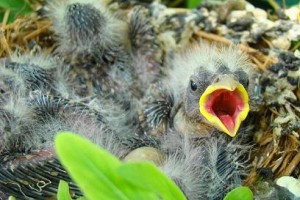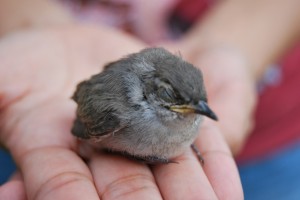
Orphaned or Injured Birds
Orphaned Birds
 At some point, nearly everyone who spends time outdoors finds a baby bird—one that is unable to fly well and seems lost or abandoned. Our first impulse is to adopt the helpless creature, but this often does more harm than good – and in most cases, the young bird doesn’t need our help at all.
At some point, nearly everyone who spends time outdoors finds a baby bird—one that is unable to fly well and seems lost or abandoned. Our first impulse is to adopt the helpless creature, but this often does more harm than good – and in most cases, the young bird doesn’t need our help at all.
The first thing to do is to figure out if it’s a nestling or a fledgling. If it’s sparsely feathered and not capable of hopping, walking, flitting, or gripping tightly to your finger, it’s a nestling. If so, the nest is almost certainly nearby. If you can find the nest (it may be well hidden), put the bird back as quickly as possible. Don’t worry – parent birds do not recognize their young by smell!
If the bird is feathered and capable of hopping or flitting, and its toes can tightly grip your finger or a twig, it’s a fledgling. Fledglings are generally adorable, fluffy, with a tiny stub of a tail. It’s easy to jump to the conclusion that the bird has been abandoned and needs you. But fledglings need a special diet, and they need to learn about behavior and vocalizations from their parents—things we can’t provide.
Fortunately, the vast majority of “abandoned” baby birds are perfectly healthy fledglings. Their parents are nearby and watching out for them. The parents may be attending to four or five young scattered in different directions, but they will most likely return to care for the one you have found shortly after you leave.
When fledglings leave their nest they rarely return, so even if you see the nest it’s not a good idea to put the bird back in—it will hop right back out. Usually there is no reason to intervene at all beyond putting the bird on a nearby perch out of harm’s way. Fledglings produce sounds that their parents recognize, and one of them will return and care for it after you leave.
If you have found both parents dead or are otherwise absolutely certain that the bird was orphaned, then your best course of action is to bring it to a wildlife rehabilitator. The National Zoo has excellent information on emergency care until you can get an injured or truly abandoned bird to a wildlife rehabilitator.
Injured Birds
 Once in a while people come upon a bird acting lethargic and sick. We’re most likely to see sick birds at our feeders. Why? Our feeders provide an up-close and personal look at the birds in your yard, making it easier to detect one acting different from the rest. Also, some sick birds are actually drawn to feeders, needing an easy meal. But people also find sick birds in lawns after spraying, during outbreaks of West Nile Virus, and in other situations.
Once in a while people come upon a bird acting lethargic and sick. We’re most likely to see sick birds at our feeders. Why? Our feeders provide an up-close and personal look at the birds in your yard, making it easier to detect one acting different from the rest. Also, some sick birds are actually drawn to feeders, needing an easy meal. But people also find sick birds in lawns after spraying, during outbreaks of West Nile Virus, and in other situations.
What should you do if you find one? Don’t take it to a rehabber or veterinarian before calling to make sure they can take it. Some clinics simply don’t have the facilities to isolate sick birds, and can’t take the risk of spreading a communicable disease among their other birds. To protect yourself, your family, and your pets, don’t handle any potentially sick bird without disposable gloves, and make sure you have a box prepared for it, and a place to bring it, before you put it through the trauma of capture.
If your area is possibly having an outbreak of West Nile Virus or other disease, you may need to report it to your county health department or department of natural resources. To find out, call your nearest game warden or conservation office.
Prevention is the key to avoiding the spread of disease. Regularly clean your feeders even when there are no signs of disease. A 10% bleach solution is often recommended and some feeders can even be placed in your dishwasher. If a sick bird does come to your feeder, minimize the risk of infecting other birds by cleaning your feeder area thoroughly. If you see several diseased birds, take down all your feeders for at least a week to give the birds a chance to disperse. And make sure to keep your birdbaths clean. Water allowed to sit for more than a few days can provide perfect breeding habitat for the very mosquitoes most likely to spread West Nile Virus.